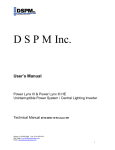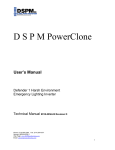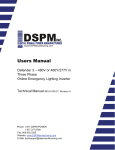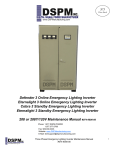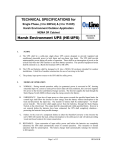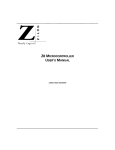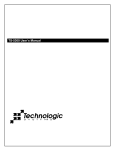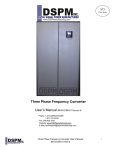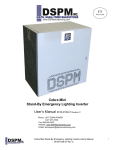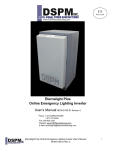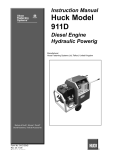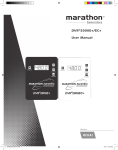Download User Manual
Transcript
D S P M Inc. User’s Manual Power Lynx 1 Uninterruptible Power System Technical Manual #018-0056-10 Revision nr Phone: (714) 970-2304 Fax: (714) 970-6171 Service: (714) 970-2304 (m-f, 8:00 – 5:00), after hours (951) 840-0811 Web Page: www.DSPManufacturing.com Email: [email protected] 1 Congratulations on selecting one of the fine products from DSPM, the leader in power protection technology. Our wide product offering includes Uninterruptible Power Systems (UPS), Power Conditioners, Frequency Converters and Specialty Transformers. Since our beginnings DSPM has shipped many of these fine products to discerning customers for use on sensitive equipment and critical loads. HEADQUARTERS DSPM Inc 1921 S. Quaker Ridge Place Ontario Ca, 91761 SALES Phone (714) 970-2304 Fax. No. (714) 970-6171 www.DSPManufacturing.com Email: [email protected] SERVICE Phone (714) 970-2304 (m-f, 8:00 AM – 5:00 PM) Phone (951) 840-0811 (after 5:00 PM) Fax. No. (714) 970-6171 Phone: (714) 970-2304 Fax: (714) 970-6171 Service: (714) 970-2304 (m-f, 8:00 – 5:00), after hours (951) 840-0811 Web Page: www.DSPManufacturing.com Email: [email protected] 2 DSPM Inc. Proprietary Reproduction or Distribution forbidden NOTICE: THIS DOCUMENT CONTAINS PROPRIETARY INFORMATION This document contains proprietary and confidential information of DSPM Inc. (“DSPM”). In consideration of the receipt of this document, the recipient agrees not to copy any of its contents, nor disclose them to or allow them to be used by any person not currently a DSPM employee or an employee of the recipient having a need to know, without the express written consent of DSPM, and further agrees to surrender this document to DSPM when the reason for its receipt has terminated. Phone: (714) 970-2304 Fax: (714) 970-6171 Service: (714) 970-2304 (m-f, 8:00 – 5:00), after hours (951) 840-0811 Web Page: www.DSPManufacturing.com Email: [email protected] 3 SAFETY Important Safety Instructions Save These Instructions This manual contains important instructions for the Power Lynx 1 UPS System and should be followed during the installation, operation and maintenance of the UPS system. IMPORTANT SAFETY When using Electrical Equipment, basic safety precautions should always be followed, including the following: IMPORTANT SAFEGUARDS READ AND FOLLOW ALL SAFETY INSTRUCTIONS 1. Do not mount near gas or electric heaters. 2. Check that all electrical connections are tightened properly. 3. Equipment should be mounted in a location to prevent tampering by unauthorized personal. 4. Equipment should be locked at all times. 5. Only DSPM trained personnel should be permitted to service or maintain equipment. 6. Only accessories recognized by DSPM shall be used with this equipment. Contact DSPM if options are desired. Phone: (714) 970-2304 Fax: (714) 970-6171 Service: (714) 970-2304 (m-f, 8:00 – 5:00), after hours (951) 840-0811 Web Page: www.DSPManufacturing.com Email: [email protected] 4 BATTERY SHELF LIFE-STORAGE The batteries must be recharged every 4 months for at least eight hours or the batteries can be damaged. If the UPS is placed in storage, failure to re-change batteries will invalidate your warranty. BATTERY SAFETY 1. Person knowledgeable of batteries and the required precautions should perform servicing of batteries. 2. Do not dispose of batteries in a fire. The battery may explode. 3. Do not open and manipulate the battery 4. A battery can present a risk of electrical shock and high short circuit current. Remove watches, rings or any other metal objects. Use only insulated tools. 5. Install in a protected environment. 6. Always turn off the battery circuit breaker before testing or performing maintenance on the battery system. WARNING It is strongly advised not to open the UPS cabinet as the components have very high voltages and touching them may be fatal. Only a technician from DSPM or a DSPM trained technician may service the unit. Phone: (714) 970-2304 Fax: (714) 970-6171 Service: (714) 970-2304 (m-f, 8:00 – 5:00), after hours (951) 840-0811 Web Page: www.DSPManufacturing.com Email: [email protected] 5 SECTION 1- OPERATION 1-1 INTRODUCTION The POWER LYNX UPS (uninterruptible power system) from DSPM provides an exceptional level of load protection and monitoring capabilities. The critical load is provided with conditioned, regulated, computer- grade power at all times. Both the voltage level and frequency are controlled at all times to the load. When the input power is lost to the UPS, such as during a power outage, the UPS automatically draws power from its internal battery supply. The critical load receives only clean sine wave power at all times. There are no disturbances or power interruptions on the output when the UPS transfers to battery operation. Transfers to and from battery operations are “No Break” transfers. The internal maintenance-free batteries provide a few minutes to hours (depending upon model) of backup power. Upon restoration of input power, the UPS automatically resumes normal operation. Also the UPS immediately begins to recharge the batteries. The POWER LYNX 1 is a dual conversion single phase UPS available in output ratings of 2 to 80 kVA. The UPS is U.L. listed under UL1778 and/or UL924. The UPS is available with input voltages of 120, 208, 240 and 277 VAC; and output voltages of 277, 240, 208, and 120 VAC. This information is provided on the nameplate located on the inside of the front door. 1-2 BENEFITS The POWER LYNX 1 is designed to fit the needs for virtually all power conditioning and UPS applications. It has been specifically designed to power all forms of modern data processing, communications, process control equipment, lighting and emergency lighting equipment. The UPS does not require any derating as other UPS products may when powering 100% electronic loads including switch-mode power supplies. The POWER LYNX 1 protects sensitive electrical equipment, such as computer systems, telecommunication networks, LANs, multi-user systems and instrumentation systems from electrical interference. The UPS protects these systems from power problems associated with poor quality AC power including complete power outages. Phone: (714) 970-2304 Fax: (714) 970-6171 Service: (714) 970-2304 (m-f, 8:00 – 5:00), after hours (951) 840-0811 Web Page: www.DSPManufacturing.com Email: [email protected] 6 1-2 BENEFITS (continued) Electrical disturbances can come from practically anywhere: from the incoming power lines and from within a building. Outside electrical disturbances include lightning strikes, utility switching, brownouts, and accidents. Electrical disturbances from within the building can be caused by load cycling (elevators, HVAC systems) fault conditions, welders, and other electrically noisy equipment. Whether the electrical disturbances are generated outside or from within the facility, the following power problems will occur: • • • • • Complete power outages Brown-outs including momentary sags Voltage surges Transients including common-mode and transversemode noise Frequency shifts and fluctuations Sensitive electrical equipment needs protection from power problems. Without power protection, users of sensitive equipment may experience: • • • • • • • • Loss of data including data corruption Database corruption Equipment and component deterioration Premature equipment failures Unexpected equipment failures Missed deadlines, especially during batch processing Loss of real-time transaction processing Loss of employee productivity Phone: (714) 970-2304 Fax: (714) 970-6171 Service: (714) 970-2304 (m-f, 8:00 – 5:00), after hours (951) 840-0811 Web Page: www.DSPManufacturing.com Email: [email protected] 7 Phone: (714) 970-2304 Fax: (714) 970-6171 Service: (714) 970-2304 (m-f, 8:00 – 5:00), after hours (951) 840-0811 Web Page: www.DSPManufacturing.com Email: [email protected] 8 (Typical left hand view) Phone: (714) 970-2304 Fax: (714) 970-6171 Service: (714) 970-2304 (m-f, 8:00 – 5:00), after hours (951) 840-0811 Web Page: www.DSPManufacturing.com Email: [email protected] 9 (Typical right hand view) Phone: (714) 970-2304 Fax: (714) 970-6171 Service: (714) 970-2304 (m-f, 8:00 – 5:00), after hours (951) 840-0811 Web Page: www.DSPManufacturing.com Email: [email protected] 10 1-3 PRODUCT FEATURES The following describes the major sub-systems within the POWER LYNX 1 UPS. INPUT AND OUTPUT FILTER – The input filter reduces the input transients and harmonics on the input line. This helps protect the electronic circuitry of the UPS. The output filter filters and noise and line spikes from loads. INPUT POWER FACTOR CORRECTION - The POWER LYNX 1 UPS system includes state – of – the – art input power factor correction. This greatly reduces the amount of current demanded from your building wiring system, yielding a highly efficient “Building Friendly” UPS System. RECTIFIER/INVERTER The Rectifier-Inverter system provides controlled sine wave power to the output. The output voltage and frequency are monitored by the microprocessor and controlled to provide precision power with changing inputs and outputs to the UPS system. MICROPROCESSOR, Display The microprocessor monitors the input and the output to the UPS system and corrects for any abnormal condition that may occur. This is displayed on the display for operator information. DIAGNOSTIC TESTS When you start the UPS, a diagnostic test is automatically executed that checks the electronics, batteries, and reports and problems on the display. Phone: (714) 970-2304 Fax: (714) 970-6171 Service: (714) 970-2304 (m-f, 8:00 – 5:00), after hours (951) 840-0811 Web Page: www.DSPManufacturing.com Email: [email protected] 11 SECTION 2 – PREINSTALLATION 2-1 SITE PLANNING AND PREPARARTION The POWER LYNX 1 is designed for installation indoors where it is protected from the elements. The UPS can be installed in a variety of different environments including computer rooms, offices, and industrial/process control locations. For the best performance and reliability, temperature extremes should be avoided. Listed below are the environmental specifications for the POWER LYNX 1 UPS SYSTEM. Adequate clearance around the equipment should be provided for service access and proper equipment cooling. The UPS must be protected from contact with water and other liquids. If the UPS is installed in a small, enclosed area, provisions for additional cooling may be necessary. OPERATING ENVIRONMENT. Provide an operating environment that meets the following conditions: o AMBIENT TEMPERATURE 32° to 104°F 0° to 40°C o OPERATING ALTITUDE 2,286 M (7500 FT) o NON-OPERATING ALTITUDE up to 3,048 M (10,000 FT) o RELATIVE HUMIDITY 0% to 95% (non-condensing) Operating the UPS and batteries at either extreme of the temperature range may affect the long-term reliability of the system. This is especially true of the sealed, maintenance-free batteries. Sealed, maintenance-free batteries are designed to operate at normal room temperatures (72 to 77° F) ! WARNING ! BATTERY SHELF LIFE ! • BATTERY SHELF LIFE, WHEN STORED UNDER TEMERATURE CONDITIONS of 66° F ~ 77° F, is FOUR (4) MONTHS MAXIMUM AFTER THE SHIP DATE. • BATTERY MUST BE RECHARGED FOR EIGHT HOURS AFTER THIS DATE OTHERWISE THEY MAY BE DAMAGED. Phone: (714) 970-2304 Fax: (714) 970-6171 Service: (714) 970-2304 (m-f, 8:00 – 5:00), after hours (951) 840-0811 Web Page: www.DSPManufacturing.com Email: [email protected] 12 SECTION 2 – INSTALLATION The POWER LYNX 1 UPS system is shipped on a pallet with the batteries outside the UPS. This Manual, battery jumper wires and accessories may be included within the packaging, ensure that these are not discarded with the packaging. Unwrap the UPS and carefully inspect the external surfaces for abrasions, indentations, or other obvious damage. File a claim with the shipping agency for any damage caused by shipping. Forward a copy of the damage claim to DSPM. Mount the UPS system so each side and the top has six inches of clearance for airflow. Leave appropriate space in the front so the front door can be opened fully for operation and installation. 2-1 INSTALLATION EQUIPMENT The following instructions cover general requirements for standard installation of the input and output power circuits, battery connections and control interface connections. Install the UPS using the procedures in this section. Care must be taken to insure the unit is properly connected. Connections should be torque as shown in Table 2-1 TABLE 2-1 WIRING TERMINAL TORQUE DANGER!! THE UPS CONTAINS POTENTIALLY LETHAL VOLTAGES INSIDE, EVEN IF THE UNIT IS NOT CONNECTED TO AN EXTERNAL SOURCE OF POWER. ALL INSTALLATION AND SERVICE PROCEDURES SHOULD BE PERFORMED BY QUALIFIED PERSONNEL ONLY. Phone: (714) 970-2304 Fax: (714) 970-6171 Service: (714) 970-2304 (m-f, 8:00 – 5:00), after hours (951) 840-0811 Web Page: www.DSPManufacturing.com Email: [email protected] 13 The input power circuit is supplied by the customer. This provides power from the building source to the UPS system. This circuit should be a dedicated branch circuit that is hard wired in conduit. Size the branch circuit feeder conductors according to the specific power rating of the unit. Refer to the latest edition of National Electric Code (NEC) for the exact wire size required. An insulated grounding conductor must be installed as part of the input circuit. Size the grounding conductor in accordance with NEC and local codes. The manufacturer recommends a parity-sized ground, with respect to the input power wires. 2-1 INSTALLATION OF EQUIPMENT (continued) The UPS is designed to provide superior isolation and protection for sensitive loads. The UPS can be wired as a separately derived source that allows the re-establishing of the ground reference at the output of the UPS. This method of installation will provide additional load isolation from noise and other disturbances. DANGER!! INSURE THAT ALL CODE REQUIREMENTS ARE FOLLOWED IN GROUNDING THE UPS AND ITS LOADS. BODILY INJURY OR DAMAGE TO EQUIPMENT MAY OCCUR IF UNIT IS NOT PROPERLY GROUNDED. NOTE The equipment to be connected to the UPS may require special grounding procedures. Refer to technical documentation which accompanies that equipment. Phone: (714) 970-2304 Fax: (714) 970-6171 Service: (714) 970-2304 (m-f, 8:00 – 5:00), after hours (951) 840-0811 Web Page: www.DSPManufacturing.com Email: [email protected] 14 2-2 INPUT CONNECTIONS 1. Verify that power source to the unit is OFF, locked and tagged according to OSHA requirements. CAUTION Verify that the input voltage as stated on the UPS nameplate, matches the customer-supplied voltage. If the voltage does not match, STOP installation of the UPS and contact Customer Service at DSPM. 2. Verify that Input cable and conduit are routed correctly and are in position to 3. 4. 5. 6. 7. connect the unit. Open front doors of UPS Select desired mounting hole and remove knockout. Pass wires through the mounting hole. Secure conduit fitting to the panel of unit. Connect input bypass wires to the TB1 input as indicated by the label. Connect input rectifier wires to TB2 input as indicated by the label. These connection will be Ground Neutral, Hot or Ground, Hot, Hot. Both of these inputs are pre-wired to the input circuit breakers CB1 and CB2. (Input terminals blocks and breaker) G, N, H Bypass Input TB1 G, H, H Rectifier Input TB2 Bypass Input Circuit Breaker CB1 Rectifier Input Circuit Breaker CB2 Phone: (714) 970-2304 Fax: (714) 970-6171 Service: (714) 970-2304 (m-f, 8:00 – 5:00), after hours (951) 840-0811 Web Page: www.DSPManufacturing.com Email: [email protected] 15 2-3 OUPUT CONNECTIONS 1. Verify that power source to the unit is OFF, locked and tagged according to OSHA requirements. CAUTION Verify that the output voltage as stated on the UPS nameplate matches the actual output voltage of the unit. Ensure that the intended connected load does not exceed unit capacity. If the voltage does not match, or the intended applied load exceeds unit capacity, STOP installation of the UPS and contact Customer Service at DSPM. 2. Verify that Output cable(s) and conduit(s) are routed correctly and are in position to connect the unit. 3. Open front doors of UPS. 4. Select desired mounting hole(s) and remove knockout. 5. Pass wires through the mounting hole. 6. Secure conduit fitting to the panel of unit. 7. Connect the output wires to the output circuit breaker(s), neutral and ground terminal blocks. Note: Ensure that the applied loads wired to the unit are evenly balanced. Loads to be evenly distributed to all output circuit breakers provided. Output Terminal Blocks TB4 G, N, H Output Circuit Breaker CB4 Phone: (714) 970-2304 Fax: (714) 970-6171 Service: (714) 970-2304 (m-f, 8:00 – 5:00), after hours (951) 840-0811 Web Page: www.DSPManufacturing.com Email: [email protected] 16 2-4 BATTERIES AND BATTERY CABLES WARNING!! FOLLOW THE BATTERY SAFETY PROCEDURE IN THE FRONT OF THIS MANUAL. If the UPS is provided with batteries the UPS system will have fixed battery trays. All battery systems connect the batteries in series, i.e. plus terminal to minus terminal from one battery to another battery. The battery circuit breaker must be off during the installation. Install the batteries and connect the battery cables. Connect the minus (-) terminal of the battery group to the battery circuit breaker terminal that is labeled (-). Connect the positive (+) terminal of the battery group to the battery circuit breaker terminal that is labeled (+). (Follow Battery diagram in the unit for installation.) BATTERY SYSTEM TEST 1. Make sure A.C. input circuit breaker is OFF. 2. Make sure battery circuit breakers are OFF. 3. Use a meter and note the D.C. voltage at the battery circuit breaker. The voltage must be the correct polarity positive lead of the meter to the positive terminal of the terminal block. 4. The D.C. voltage should read between 220 to 240 VDC for an 18-battery unit and 118 to 130 for a 10-battery unit. If the D.C voltage reads below 210 volts D.C., or 115 volts DC, this means the battery cables are not connected correctly. 5. If the battery polarity and voltage level are correct, continue to “Starting the UPS”. Battery Breaker CB3 Battery Terminal Block TB3 Phone: (714) 970-2304 Fax: (714) 970-6171 Service: (714) 970-2304 (m-f, 8:00 – 5:00), after hours (951) 840-0811 Web Page: www.DSPManufacturing.com Email: [email protected] 17 3-0 OPERATIONS 3-1 STARTING THE UPS 1. 2. 3. 4. 5. 6. 7. 8. 9. Check the input A.C. circuit breaker is OFF. Check all output circuit breaker(s) (optional) are OFF. Check the battery circuit breaker(s) are OFF. Energize the Utility feeder to the unit. Turn the Input circuit breaker ON. Wait for the System display message instructing you to close the battery breaker. Turn on the Battery Breaker. Wait for the System Display message stating unit is operational. Turn on the Output Breaker. System Display Panel Phone: (714) 970-2304 Fax: (714) 970-6171 Service: (714) 970-2304 (m-f, 8:00 – 5:00), after hours (951) 840-0811 Web Page: www.DSPManufacturing.com Email: [email protected] 18 History Log Key: The History Log is used to record certain events that reflect the status and operating mode of the unit. There are 64 lines (00 through 63). It is read by holding down the Alarm Scan button. Each time the button is pressed, the log is read sequentially with the most recent event being displayed first. After 00 is displayed, the system will cycle around to 63. After 64 events are logged, the system will start recording again at 00. Code Message Description 00 01 02 04 05 07 08 09 10 11 12 00 alarm clr Phase SEQ Input OV Input UV Input CONT Outpt HiV Output LoV Outpt OFrq Outpt UFrq Phase FLT 13 Invrtr FLT 14 15 16 17 18 20 21 22 23 24 DC Bus OV DC Bus UV Input OFrq Input UFrq RECT off Invrt Ofrq Invrt UFrq ISBS open USBS fault USBS short 26 28 35 36 37 Output OVL Estop OPEN UPS abort Normal run BATT test Blank – used in clearing Alarm History Alarm History has been cleared Input phase sequence has caused a fault and must be changed Input voltage has gone over fault limit Input voltage has gone below fault limit System has failed to detect closure of the Input Contactor Output voltage has gone over fault limit Output voltage has gone below fault limit Output frequency has gone over fault limit Output frequency has gone below fault limit Input phase sequence fault has not been corrected and system has timed out a hardware fault has been detected by the inverter control board (IGBT PCBA); caused by IGBT failure, unexpected power on reset, or DC Bus over voltage DC Bus has gone over fault limit DC Bus has gone below fault limit Input frequency has gone over fault limit Input frequency has gone below fault limit Rectifier has shut off unexpectedly Inverter frequency has gone over fault limit Inverter frequency has gone below fault limit Inverter Static Bypass Switch has not engaged and system has timed out Utility Static Bypass Switch has failed test Utility Static Bypass Switch failure, output voltage still detected after off command was issued Output Current has gone over fault limit Emergency Stop option enabled during system power-up System faults have caused system to switch to bypass Automated system test concluded Automated system test initiated (15 minute rectifier shutoff and battery Phone: (714) 970-2304 Fax: (714) 970-6171 Service: (714) 970-2304 (m-f, 8:00 – 5:00), after hours (951) 840-0811 Web Page: www.DSPManufacturing.com Email: [email protected] 19 38 40 41 42 43 45 46 47 49 50 51 52 53 54 56 57 58 Inv start NMI trap STKUF trap STKOF trap WDTMR trap ISBS xfer Inv Stop Pwr on RST ESTOP trap RunState0 RunState1 RunState2 RunState3 Bypass on Battry Low KeyCode OK AirFlow DN run) Inverter has been started and matched with utility voltage NMI button on processor board has been pressed, date and time marker Software Stack underflow detected Software Stack overflow detected Software has detected a Watchdog timer overflow Static Bypass Switch has transferred load to Inverter Inverter has unexpected shut off CPU initialization complete Emergency Stop option has caused an emergency transfer to utility Power has been applied to system Initial system checks complete, awaiting DC breaker closure Startup complete, system ready Utility power failure, system is on a battery run System is in bypass Battery Voltage is low, causes a system shutdown Key Code Accepted AirFlow fault detected, DC BUS set to minimum value CAUTION Verify that the output voltage as stated on the UPS nameplate matches the actual output voltage of the unit. Ensure that the intended connected load does not exceed unit capacity. If the voltage does not match, or the intended applied load exceeds unit capacity, STOP installation of the UPS and contact Customer Service at DSPM. Phone: (714) 970-2304 Fax: (714) 970-6171 Service: (714) 970-2304 (m-f, 8:00 – 5:00), after hours (951) 840-0811 Web Page: www.DSPManufacturing.com Email: [email protected] 20 3-2 TURNING THE UPS SYSTEM OFF 1. Turn OFF the output circuit breakers. 2. Turn OFF the input A.C. Bypass and Rectifier circuit breakers. 3. Turn OFF the battery circuit breaker. 4-2 OUTPUT POWER 1. Normally on circuits can be provided. These circuits are on when AC input power is on and turned off to lower the load requirements where input AC power fails. 2. Normally off circuits can be provided. These circuits provide power only when the UPS system is on battery power. These circuits usually power exits signs and lighting. 5.0 TECHNICAL SUPPORT 1. For Technical Support or any questions not covered in this manual, contact: DSPM Power-Clone 5407 E. La Palma Avenue Anaheim, CA 92807 714.970.2304 714.970.6171 [email protected] Phone: (714) 970-2304 Fax: (714) 970-6171 Service: (714) 970-2304 (m-f, 8:00 – 5:00), after hours (951) 840-0811 Web Page: www.DSPManufacturing.com Email: [email protected] 21 6.0 Maintenance CAUTION: DO NOT DISPOSE OF BATTERIES IN FIRE CAUTION: DO NOT ATTEMPT TO OPEN THE BATTERIES CAUTION: THE FOLLOWING PRECAUTIONS SHOULD BE TAKEN WHEN REPLACING ANY BATTERIES • REMOVE WATCHES, RINGS, ETC… • USE TOOLS WITH INSULATED HANDLES. CAUTION: USE RUBBER PROTECTIVE GLOVES WHEN HANDLING DAMAGED BATTERIES. WARNING: HIGH VOLTAGE IS PRESENT ON BATTERIES. 1. Semi-annual i. Cabinet/Electronics 1. Inspect all fans and insure proper operation. ii. Batteries/Battery Cabinet 1. Inspect the battery cases for leakage. 2. Perform a battery load test of each individual battery. a. Turn off the Battery Breaker b. Using a Battery load tester connected to only one battery test the battery and record the battery voltage after a 5 to 10 second load test. The picture to the left is an example of the type load tester that can be used. c. Repeat step “b.” using the same timed load test, and record the data. d. After the testing all the batteries, compare the test data. All recorded voltages should be approximately the same value. Any batteries that have a reading considerably different then the others needs to be investigated, or considered to be bad and replaced. Phone: (714) 970-2304 Fax: (714) 970-6171 Service: (714) 970-2304 (m-f, 8:00 – 5:00), after hours (951) 840-0811 Web Page: www.DSPManufacturing.com Email: [email protected] 22 e. Check wiring for proper routing and damage, such as chaffing and/or cutting. Relocate and /or repair and found damaged wires. f. Check the torque of each battery connection for 70in/lbs. CAUTION: DO NOT OVER TORQUE THESE CONNECTION AS SOME BATTERIES HAVE LEAD POSTS AND THEY ARE VERY EASY TO COMPRESS AND WILL CAUSE FAILURES IN THE FUTURE. Note: If Batteries are found to be leaking or fail the load test they should be replaced. (Consult DSPM as to the status of your Battery Warranty) 2. Annual CAUTION: BEFORE PERFORMING ANY OF THE FOLLOWING STEPS BESURE THAT THE UPS/EMERGENCY LIGHTING INVERTER HAS BEEN TUNED OFF. i. Perform all Semi-annual Maintenance. ii. Cabinet/Electronics 1. Inspect all power connections for loose connections. Tighten any that are found loose. See the Torque table below. 2. Check wiring for proper routing and damage, such as chaffing and/or cutting. Relocate and /or repair and found damaged wires. 3. Exercise all circuit breakers. 4. If there is a distribution internal to the cabinet and/or a panel attached to the side of the UPS/Emergency Lighting Inverter, check the power connections and exercise the breakers in the cabinet. iii. Batteries/Battery Cabinet. 1. Check wiring for proper routing and damage, such as chaffing and/or cutting. Relocate and /or repair and found damaged wires. Phone: (714) 970-2304 Fax: (714) 970-6171 Service: (714) 970-2304 (m-f, 8:00 – 5:00), after hours (951) 840-0811 Web Page: www.DSPManufacturing.com Email: [email protected] 23 2. Check the torque of each battery connection for 70in/lbs. CAUTION: DO NOT OVER TORQUE THESE CONNECTION AS SOME BATTERIES HAVE LEAD POSTS AND THEY ARE VERY EASY TO COMPRESS AND WILL CAUSE FAILURES IN THE FUTURE. Note: If Batteries are found to be leaking or fail the load test they should be replaced. (Consult DSPM as to the status of your Battery Warranty) 7.0 TROUBLE SHOOTING 7.0.1 If unable to resolve any problem please contact DSPM-PowerClone for assistance. DSPM-PowerClone 5407 E. La Palma Avenue Anaheim, CA 92807 714.970.2304 714.970.6171 [email protected] Phone: (714) 970-2304 Fax: (714) 970-6171 Service: (714) 970-2304 (m-f, 8:00 – 5:00), after hours (951) 840-0811 Web Page: www.DSPManufacturing.com Email: [email protected] 24
























